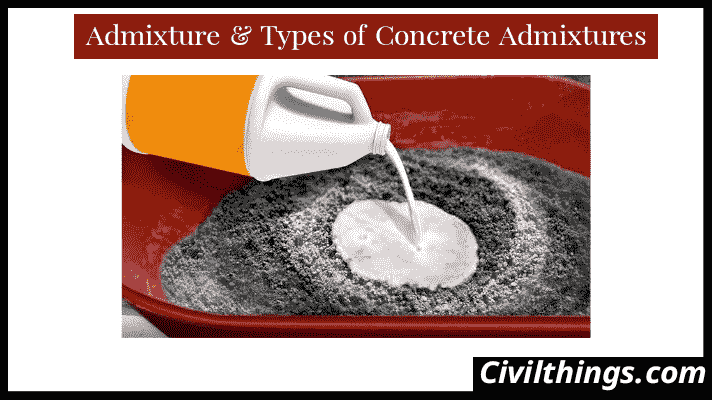Why admixtures is used in concrete?
“Admixtures is an important factor. Admixtures for cement and concrete are prepared using different chemicals, which are added in specific proportions to the cement mixture. Using admixtures reduces the consumption of water and does not compromise the strength of the concrete, thus reducing construction time. There are many types of admixtures, and they vary based on location. We will delve into further details.
From this critical foundation, you’ll understand the types of admixtures, how they work, their advantages, and their uses. Exam Point of U will present all this information in a simple and comprehensible manner.”
Table of Contents
What do you mean by admixture? Definition of Admixture
A material other than water, aggregate, and hydraulic cement, used as an ingredient of concrete or mortar and added to the batch immediately before or during its mixing, to modify one or more of the properties of concrete in the plastic or hardened state, is termed as Admixture.

Which admixture is used in cement? Classification / Type of Admixture ( Total 17 )
Note – Mostly the First 5 Admixture Asked in your Exam and in this post we also explain 1st 5 Admixture in Detail
- Plasticizer Admixture
- Super Plasticizer Admixture
- Retarding Admixtures
- Accelerating Admixtures
- Air Entraining Concrete Admixture
- Pozzolanic Admixtures
- Damp-proofing Admixtures
- Gas forming Admixtures
- Air detraining Admixtures
- Alkali Aggregate Expansion Preventing Admixtures
- Anti-washout Admixtures
- Workability Administer
- Grouting Admixtures
- Corrosion Preventing Admixtures
- Bonding Admixtures
- Fungicidal, Germicidal, Insecticidal Admixtures
- Coloring Admixtures
1. Plasticizer Admixture
“Plasticizer admixture makes water go away by breaking it into small particles. This makes the water amount needed become less by fifteen percent. Inside cement grains, there is a reaction because of a chemical. This makes the attraction force between cement grains weaker and they become separate. Then, the rippling force changes to become smooth. Because of this, all the water inside it goes away and the water amount needed becomes less by up to fifteen percent.”
2. Superplasticizer Admixture
Superplasticizers were developed in Japan and Germany between 1960 and 1970.
These are an advanced form of plasticizers, and this admixture helps reduce the amount of water needed in concrete by up to 30%.
Think of this admixture as a special ingredient that acts like a super version of a plasticizer. It makes the concrete more flexible without needing as much water.
3. Accelerator Admixture
The Accelerator Admixture is like a special ingredient in concrete. It makes a chemical reaction happen faster when the concrete is getting hard because of heat and water.
commonly used admixtures are calcium formate, silica fume .calcium chloride (commonly used)
We use it for a few important reasons:
– It helps concrete become strong quickly.
– It makes the concrete turn hard faster, so builders don’t have to wait as long.
– This is handy for when we need to finish a job in a hurry.
– It’s especially useful in places where it’s very cold, like Jammu and Kashmir, because it helps the concrete not freeze too slowly.
So, in simple words, the Accelerator Admixture makes concrete strong fast, and it’s great for getting work done quickly, especially in chilly areas like Jammu and Kashmir.
4. Retarder Admixtures
In this admixture, the chemical reaction of heat hydration is very slow.
Ingredients – Gypsum, starch, sugar, salts of acids
This method is used in hot weather areas and the RMC plant This added mixture makes the initial setting time slow for a concrete mixture.
5. Air Entraining Concrete Admixture
The Air Entraining Concrete Admixture is like a special ingredient you can put in the concrete mix. This ingredient was invented a long time ago in 1930.
Ingredients – Vinsol resin, Darex, Teepol
Two types of air-entering administrator
- Air enters the concrete
- There which trapped In the concrete
It helps air get inside the concrete while you’re mixing it. Think of it like blowing up a balloon inside the concrete mix. These tiny air bubbles make the concrete more robust and better at handling cold weather because it gives it some flexibility.
It also keeps some air trapped inside the concrete. This trapped air makes the concrete even more durable, especially when it’s freezing outside. It’s like having little pockets of air that protect the concrete from breaking.
So, in simple words, the Air Entraining Concrete Admixture helps make concrete stronger and better at dealing with tough weather by adding tiny air bubbles inside it. It’s like giving your concrete some superpowers!
Difference Between Accelerator Admixture & Retarder Admixture
| Property | Accelerator Admixture | Retarder Admixture |
|---|---|---|
| Function | Speeds up the setting and curing time of concrete | Delays the setting and curing time of concrete |
| Purpose | Used in cold weather or when a faster setting time is desired | Used in hot weather or to provide more working time for placing and finishing concrete |
| Effect on Strength | Generally does not significantly affect long-term strength | Generally does not significantly affect long-term strength |
| Temperature Sensitivity | Effective in cold temperatures | Effective in hot temperatures |
| Common Components | Calcium chloride is a common accelerator | Lignosulfonates are common retarders |
| Application Rate | Applied in small quantities | Applied in small quantities |
| Setting Time Adjustment | Reduces setting time | Increases setting time |
| Workability | May reduce workability | May improve workability, especially in hot weather |
| Compatibility | Compatible with most other admixtures | Compatible with most other admixtures |
| Considerations | Care should be taken to avoid excessive dosage, as it may lead to rapid setting | Dosage should be carefully controlled to prevent excessive delays and potential strength loss |
Types Of Admixtures Used In Construction | Type of Concrete Admixtures and their uses
Extra information about Admixture
Admixture in Concrete: Definition, Types, and Applications
Admixture plays a crucial role in modern construction by enhancing the properties of concrete. From improving strength and durability to modifying setting times, admixtures offer solutions to various challenges faced in construction projects. In this article, we’ll explore the definition, types, applications, and benefits of using admixtures in concrete.
What is an Admixture in Concrete?
An admixture is a material other than cement, water, and aggregates added to concrete before or during the mixing process. It is used to modify specific properties of concrete to meet construction requirements. Admixtures can improve the workability, strength, and durability of concrete, making them an essential component in both large-scale and small-scale projects.
Purpose of Using Admixture in Concrete
The primary reasons for using an admixture include:
- Enhancing Workability: Makes the concrete easier to place and finish.
- Adjusting Setting Time: Allows flexibility by accelerating or retarding the setting time.
- Improving Durability: Increases resistance to environmental factors like freeze-thaw cycles.
- Reducing Water Content: Lowers the water-cement ratio while maintaining workability.
- Increasing Strength: Helps achieve high-strength concrete suitable for heavy-duty applications.
Types of Admixture in Concrete
Admixtures are broadly classified into the following categories:
1. Water-Reducing Admixtures
- Reduce the water content without affecting the workability.
- Improve strength by maintaining a low water-cement ratio.
- Commonly used in large construction projects.
2. Superplasticizers
- Provide significant water reduction (up to 30%).
- Increase the flowability of concrete.
- Essential for self-compacting and high-performance concrete.
3. Air-Entraining Admixtures
- Introduce microscopic air bubbles into the concrete mix.
- Enhance durability by preventing freeze-thaw damage.
- Often used in cold climates.
4. Accelerating Admixtures
- Speed up the hydration process.
- Reduce setting time in cold weather.
- Useful in projects requiring quick turnarounds.
5. Retarding Admixtures
- Delay the setting time of concrete.
- Provide extended workability in hot weather.
- Ideal for large pours and complex structures.
Applications of Admixture in Concrete
The use of admixtures is prevalent in various types of construction, including:
- Normal Concrete: To improve workability and durability.
- High-Strength Concrete: For skyscrapers, bridges, and heavy infrastructure.
- Self-Compacting Concrete (SCC): For structures with dense reinforcement.
- Mass Concrete: Used in dams and large foundations to control heat generation.
Advantages of Using Admixture in Concrete
- Reduces construction time and labor costs.
- Enhances durability and lifespan of structures.
- Allows concrete to achieve desired strength with lower cement content.
- Provides flexibility in extreme weather conditions.
- Improves the finish and appearance of concrete surfaces.
Factors to Consider When Using an Admixture
While using an admixture, consider the following factors:
- Compatibility: Ensure the admixture is compatible with other materials in the concrete mix.
- Dosage: Follow the manufacturer’s guidelines for correct dosage.
- Mixing Process: Proper mixing is essential to achieve the desired effects.
- Environmental Conditions: Adjust the admixture type based on temperature and humidity.
Conclusion –
In this post, we’ve explored 17 different types of admixtures, each with its unique purpose and benefits.
From plasticizers that reduce water requirements to super-plasticizers that increase flexibility, accelerator admixtures for faster strength development, retarder admixtures for extended setting times, and air-entraining admixtures that enhance durability, these additives offer solutions to various concrete challenges.
Important Links
Bamboo crash barrier used in National Highway Construction
15+ Trending Admixtures used in Construction
Highly Used Cement Type in National Highway Construction
FAQ – Admixture
What do you mean by admixture?
Admixture refers to the process of combining different substances to create a mixture. It can involve the blending of various elements, often to achieve specific properties or characteristics.
What is admixture in DNA?
In the context of DNA, admixture refers to the presence of genetic material from different ancestral groups in an individual’s genome. It occurs when individuals from diverse populations interbreed, leading to a mixture of genetic traits.
What is an admixture in race?
Admixture in the context of race refers to the blending of different racial or ethnic groups. It results in individuals having a combination of genetic traits from various ancestral backgrounds.
What is an example of an admixture?
An example of admixture is the interbreeding between people of different races or ethnicities, leading to individuals with a mix of genetic characteristics from multiple populations.
What is another word for admixture?
Synonyms for admixture include blend, mixture, amalgamation, infusion, and combination.
What is the difference between a mixture and an admixture?
While both involve combining different substances, a mixture usually implies a simple physical combination without a specific goal, whereas an admixture often implies a deliberate blending with a particular purpose, such as improving properties or achieving specific characteristics.
What are the three types of admixtures?
The three types of admixtures are air-entraining admixtures (improve freeze-thaw resistance in concrete), water-reducing admixtures (enhance workability without adding extra water), and set-controlling admixtures (delay or accelerate the setting time of concrete).
Is concrete an admixture?
Concrete can contain admixtures. Admixtures in concrete are added to achieve certain properties like improved workability, strength, durability, or other specific characteristics.
What is the difference between admixture and addition?
Admixture involves the blending or combining of different substances, often with a specific goal in mind. Addition, on the other hand, is a more general term that implies putting something together without specifying a deliberate purpose.
What is the purpose of using admixtures in concrete?
Admixtures are used in concrete to improve its performance and workability. They can reduce water content, increase strength, enhance durability, and provide better resistance to adverse environmental conditions.
Name a few common types of admixtures used in concrete.
Common types of admixtures include water reducers, accelerators, retarders, air-entraining agents, and superplasticizers.
How does a water-reducing admixture work in concrete?
Water-reducing admixtures decrease the amount of water needed in the concrete mix without compromising its workability. This helps in achieving higher strength and durability by reducing the water-cement ratio.
Explain the role of superplasticizers in concrete?
Superplasticizers are admixtures that can significantly reduce the water content in a concrete mix while maintaining its workability. This results in high-strength, highly flowable concrete.
Can admixtures be used in all types of concrete?
Yes, admixtures can be used in various types of concrete, including normal concrete, high-strength concrete, and self-compacting concrete, depending on the specific requirements of the project
How should admixtures be proportioned in a concrete mix?
Admixtures should be proportioned carefully according to the manufacturer’s recommendations and guidelines. It is essential to follow proper mixing procedures to achieve the desired results in the concrete.

Hi! I’m Sandip, a civil engineer who loves sharing about Civil Engineering & new ideas and tips. My blog helps you learn about engineering in a fun and easy way!

Comments are closed.